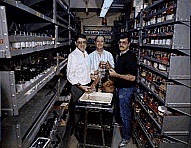The Search Goes On . . .

"If we went out to capture a giant squid today, we still wouldn't
know exactly where to look."
How long do giant squid live?
What exactly do they eat?
How deep do they live?
How quickly do they grow?
How big do they really get?
How fast do they swim?
Do they live in schools or alone?
How do their eggs get fertilized?
What happens to the eggs after they're laid?
How many species of large squid are there?
Why are they so seldom seen in the wild?
Why do they get stranded in certain areas?
Why are they so rarely captured?
Why can whales catch them, but scientists and fishermen can't?
To replace these unknowns with
facts, scientists at the National
Museum of Natural History are
collaborating with researchers
from the National Marine Fisheries
Service of the National Oceanic
and Atmospheric Administration.
 The Museum's squid squad is
building and studying a national
squid collection. Currently, it
totals about 100,000 specimens
from around the world.
The Museum's squid squad is
building and studying a national
squid collection. Currently, it
totals about 100,000 specimens
from around the world.
Photo of Clyde, Mike
Vecchione, and Mike
Sweeney in collections
area surrounded by squid
Photo credit: Harold Dougherty/National Museum of Natural History




Ocean Planet Exhibition
Floorplan

Smithsonian Giant Squid Overview Page
gene carl feldman / gene@seawifs.gsfc.nasa.gov
 Clyde F.E. Roper
Clyde F.E. Roper![]() The Museum's squid squad is
building and studying a national
squid collection. Currently, it
totals about 100,000 specimens
from around the world.
The Museum's squid squad is
building and studying a national
squid collection. Currently, it
totals about 100,000 specimens
from around the world.
![]()